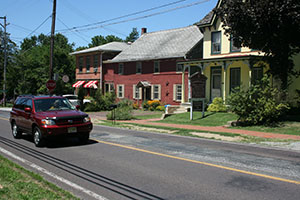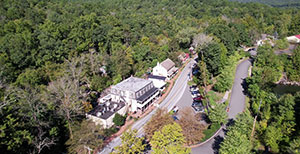Village Preservation Guide
Due to changing business needs, evolving living preferences, and ongoing development pressure, many county villages have changed dramatically or even effectively disappeared over time. Because of this, the Village Preservation Guide is designed to help local municipalities preserve their villages, while allowing these villages to change and grow to remain relevant in their communities. View Guide (PDF)
Chester County's Villages

Chester County's villages are clusters of historic buildings, typically built in rural settings by a variety of owners over time, with nineteenth century and other pre-automobile buildings dominating the village. The county's villages will normally have a central focus, smaller lots, buildings close to each other, a variety of land uses, and a distinct edge, although not all of these characteristics will be seen in every village.
Villages are smaller than towns, which usually have more diverse land uses, a much larger number of buildings, a clear downtown area, and a well-defined urban street grid system.
Currently, Chester County has 80 villages, which are located across the county. These villages run the gamut from small hamlets of a few buildings to large, mixed-use places with many services and utilities. Overall, the county has 39 hamlets, 26 traditional villages, and 15 growth area villages.
- Hamlet — A hamlet is a small grouping of historic buildings, usually five to ten, with most of these buildings residential, although there may be a church, retail store, or other non-residential building anchoring the hamlet.
- Traditional Village — A traditional village usually has more than 10 historic buildings. Most traditional villages contain some retail commercial or institutional uses, but not all have these uses.
- Growth Area Village — A growth area village has a core group of at least five historic buildings and is located within extensive new development that has affected the character of the village.
General Village Planning

Planning for a community's villages might arise in a variety of circumstances. If the municipality is preparing a comprehensive plan, the plan should incorporate recommendations for village areas. Special historic property inventories and analyses might also trigger village studies. Sometimes, particularly when historic buildings are razed or an inappropriate use is built in a village, community members request a special village study. And, finally, municipalities that are updating their zoning ordinances should examine their village areas. The following steps should be considered when conducting a village study:
- Village Identification — When planning for villages, the first step is to identify if a municipality has any villages, using a range of resources, such as local comprehensive plans, county inventories, and national register district lists.
- Village Analysis — Once villages are identified, the next step is to understand their characteristics, including:
- Village Buildings and Land Use
- Village Type
- Village Setting
- Village Road System and Access
- Village Utilities
- Planning for Future Land Use — Once a municipality's villages and their characteristics have been identified, the community must make a couple of critical land use decisions. The first is to determine the future land use of the village, particularly if nonresidential land uses will be permitted. The second decision is to determine what the land uses surrounding the village will be, particularly if the village will be within a rural setting or if it will be in a suburban growth area.
- Planning for Preservation — The most critical aspect of village preservation is doing as much as possible to preserve the historic buildings that exist in the village. The following techniques will support historic building preservation:
- Identification and Inventorying of Historic Properties
- Historic Districts
- Zoning for Historic Preservation
- Adaptive Reuse
- Prohibition on Razing of Buildings
- Allowance of More Intense Uses in Historic Buildings
- Bonus for Historic Building Preservation
- Requirement for Façade Easement or Continuation of Historic Appearance
- Design Guides
- Structured Development Review Processes
- Ownership of Historic Buildings
- Community Support of Villages
- Planning for Village-Wide Improvements — To function properly, villages, like any other place, need effective infrastructure and improvements. Local municipalities play a key role in providing these improvements, which include:
- Roads and intersections
- Traffic Calming
- Alleys and Common Driveways
- Bridges
- Sidewalks and Pathways
- Common Parking
- Streetscaping
- Gateways
- Street Trees and Landscaping
- Sewers and Water
Design Elements in Village Ordinances

Villages should have specific regulations written for their unique development patterns that will help preserve historic buildings and the overall village character. This can be done by preparing village district zoning and subdivision and land development regulations that address building character, site amenities, and transportation improvements.
Village Building Character
Building placement and design is a key unique element of villages, which are primarily composed of individual small-scaled buildings, relatively close to each other and local roads. Village zoning districts should include:
- Uses that are Appropriate for Historic Buildings
- Small Front Yard Setbacks and Build-To Lines
- Tailored Lot Size, Lot Width, and Side Yard Setbacks
- Maximum Building Footprint Sizes
- Traditional Building Design and Character
- Building Additions to Rear or Side of Historic Buildings
- Prohibition on Enclosing Porches
Site Amenities in Villages
Most village properties are relatively small and will not contain significant site amenities, except for ones between the buildings and the street, such as streetscaping and signs. Municipal zoning or subdivision and land development ordinances should regulate the following site amenities:
- Streetscaping
- Street Trees
- Semi-Private Space in Front Yards
- Village Signs
Transportation
Automobiles and other modern vehicles do not easily fit into the historic character of villages, which were not designed to accommodate these vehicles from a design, safety, use, or appearance perspective. As much as possible, the impact of cars on villages should be minimized through standards in the municipal zoning or subdivision and land development ordinances for the following transportation-related issues:
- Parking Location, which should be to the Side or Rear of Buildings
- Interconnected and Common Parking Lots
- Common Alleys and Driveways
- Sidewalks and Pathways

